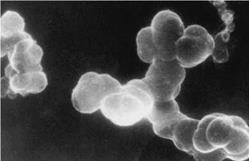4.1.1
Morphology
Electron micrographs show that the primary particles of carbon black are almost spherical in shape. In general, a larger number of such primary particles build aggregates in the form of chains or clusters. In practice, the degree of aggregation is called the “structure” of carbon black. These aggregates tend to agglomerate.
The mean primary particle diameter, the width of the particle size distribution, and the degree of aggregation can be varied within relatively wide ranges by varying the production process and several process parameters (Figure 4.1).
 F’g.4.1 Carbon black of different primary particle sizes.
F’g.4.1 Carbon black of different primary particle sizes.
The diameter of the primary particles ranges from 5 to 500 nm. Diffraction patterns produced by the so-called phase-contrast method in high-resolution electron microscopy show that the spherical primary particles are not amorphous (Figure 4.2). They consist of relatively disordered nuclei surrounded by concentrically deposited carbon layers [4.2]. The degree of order increases from the center to the periphery of each particle, a phenomenon that is important for understanding the chemical reactivity of carbon black.
 Fig. 4.2 Carbon blackaggregate.
Fig. 4.2 Carbon blackaggregate.
The carbon atoms within each layer are arranged in almost the same manner as in graphite. The layers are nearly parallel to each other. However, the relative position of these layers is random, so that there is no order as in the c direction of graphite (“turbostratic structure”) [4.3]. X-ray diffraction permits the determination of “crystalline” regions within the carbon black primary particles. These regions are parts of more extended layers, not isolated crystallites. X-ray diffraction reflexes are observed wherever parts of at least three layers are parallel and equidistant. For most carbon blacks, these “crystalline” regions are 1.5-2 nm in length and 1.2—1.5 nm in height, corresponding to 4—5 carbon layers [4.4]. The “crystalline” or well-ordered carbon fraction in carbon blacks varies, according to oxidation kinetic studies, between 60 and 90%.
The morphology ofcarbon black primary particles indicates that during the formation of carbon black, the first nuclei of pyrolyzed hydrocarbons condense from the gas phase. Thereafter, further carbon layers or their precursors are adsorbed onto the surface of the growing particles. Due to this adsorption, the new layers are always orientated parallel to the existing surface. In the case ofhigh-structure carbon blacks, several particles are joined by collision while they grow. Aggregates are formed by further carbon deposits on these initially loose agglomerates. Polyacetylene seems to play a role in the formation of precursors when aliphatic hydrocarbons are used as starting materials. With aromatic raw materials, however, it is more likely that remaining aromatic degradation products are the intermediates.
The carbon layers of carbon black rearrange to a graphitic order beginning at the particle surface at temperatures above 1200 °C. At 3000 °C, graphite crystallites are formed and the carbon black particles show a polyhedral shape.
4.1.2
 29 ноября, 2015
29 ноября, 2015  Pokraskin
Pokraskin  Опубликовано в рубрике
Опубликовано в рубрике 